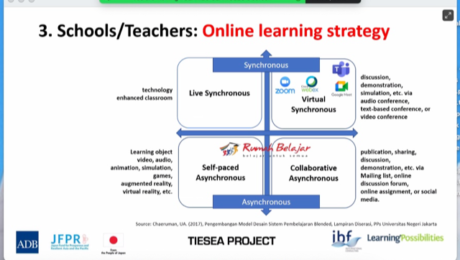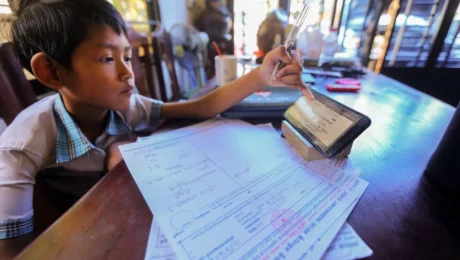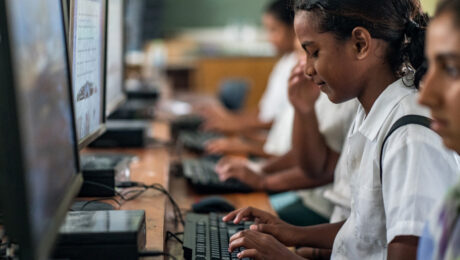Summary thoughts from the sessions
Each country has articulated a good vision. For example:

But even where the centre has got it right they have issues with local government and schools / teachers understanding and following (the reverse of most countries around the world where lead schools run ahead of policy!). A challenge for us is not to articulate great ideas at the centre, but to make actual change happen at the chalkface – bottom up, led by a vision from above.
Apparently, nobody has really thought about Location of Learning – it is very much “school” and if not school, then “home”. The reduced capital costs of “learning elsewhere” are significant – a huge advantage for these countries. Put simply, if kids “learn elsewhere” for one day per week the capital costs of learning (not teacher salaries though – still need teachers) will drop by 20% but the learning experience could be substantially enhanced.
Everyone reports that teacher development is a challenge. But teacher development is still being progressed very traditionally. In 2022 there should be much better ways to enhance that development.
The learners’ voices have not really featured in our country analyses, yet we know the advantages that learner agency can bring. They all have a lot of children. They are a solution not a problem.
Online and post pandemic get mentioned often, but the implications for this regions economy are very considerable. Top take just 3 examples: (1) working online opens the door to employment around the world. Jobs don’t have to come to the islands, or the least developed parts of these diverse economies, the employees can go to the jobs because so many jobs exist online. (2) we are already seeing employment tourism – people from wealthy developed economies seeking to live in beautiful affordable, stable places because they can work from there. (3) Schools have “survived” the pandemic, but we haven’t yet seen a robust Plan B so that the next and further pandemics will be less disruptive.
There are a LOT of commercial providers seeking to either provide hardware to all kids or content to all kids. This is not very helpful – we have heard over and over that phones + cellular connectivity are ubiquitous, even when wifi isn’t. TikTok, YouTube and much else is rich with quality learning materials – it doesn’t need to be repeated. However, knowing where to look and understanding what maps onto which curriculum components is complex and needs work.
Its not entirely clear where the blue sky thinking comes from going forwards – copying ideas from the West is no longer helpful because those schools are held back by legacy systems that are not moving, or not moving quickly enough.
STEM, as elsewhere, seems to be a very promising vehicle for progress and innovation. Probably because it hasn’t been around long enough to be ossified, but also because the nature of the activity itself is often beyond the timetable (STEM labs are more like the library than a timetabled classroom), often draws in outside experts, values the things that children know and share with each other, is compelling and maps directly onto the new skill sets of new economic realities.
Not sure where you can diplomatically put this in the report/s, but it was noticeable – eg in Indonesia event – that the case study / project talks were way ahead of the commercial partners inputs. In that case, and indeed in others too, Google and Microsoft for example were (a) disappointing and (b) really didn’t get it, or hadn’t listened to the progress Indonesia was making. Just an observation really, but if these big tech companies are to be involved, they need to servicing an initiative, not initiating one.
— – – – – – – – – – – – – – – – – —
recommendations for action. In no particular order.
They need to be impactful, affordable, inclusive actions
- “Learning Elsewhere” warrants a proper regional initiative to explore learning beyond the school campus: learning journeys around the local community (eg visits to bakers, to employment, to nature) and of course learning at home too. An open call for “Learning Elsewhere” initiatives, with small supportive funding, could trigger a lot of fresh grounded thinking.
- A region-wide STEM initiative with high levels of visibility could work everywhere regardless of money or connectivity, or devices. Maybe a simple pack of very affordable components to add “digital” to the projects could be widely available? A test piolot would be very simple to implement. This example below of a hat from a refugee project to offer both safety (who is approaching from behind) and the ability to ready at night without electricity
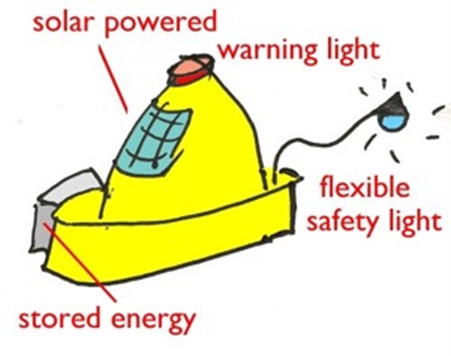
- Student agency is a key recommendation going forwards and can immediately be implemented. You can imagine a scaleable thing from every school having Learning Researchers / Champions (with proper badges), to expecting a student presence in most education events (ie the event we just ran) and perhaps a kids’ panel at the national ministries.
- The countries all worry about teacher supply and teacher training / development. But they all have a surfeit of children who could often be able to step up to help. Encouraging / rewarding / accrediting learner mentoring – older kids working with and leading younger kids – in STEM, in reading, whatever should be more than encouraged, it should be expected and we should recommend a regional accreditation of “leading learners” for children to cement and value that contribution. With all the countries on board this would be a high status and important “badge”. Beyond the badge, gains for children include meta-cognition, reflective practice, MUCH better learning and better engagement. Win win.
- Cambodia has dabbled with the idea of a Teachers’ TV type channel, whether on YouTube or satellite or both. Teachers LOVE to peek into others’ classrooms – it is very grounded, real practice ideas that they like to see. A regional TTV channel would bring a diversity of classrooms and practice, but grounded in regional realities. Cheap to implement, a powerful channel for hanging practices. A pilot would be simple to create and demonstrate.
- Everyone mentioned radio when exploring their hard to reach audiences – schools on islands, very rural schools, very poor schools (financially). I think seeking a big commercial partner (think maybe Huawei) developing a regionally produced “Radio station in a suitcase” with it’s own abiloty to broadcast across a small community but to share content via an asynchronous mesh type technology, for those schools would be an amazingly empowering project. I have the specs for such a thing. Doesn’t even need electricity – solar for the radio station, wind-up radios as receivers.
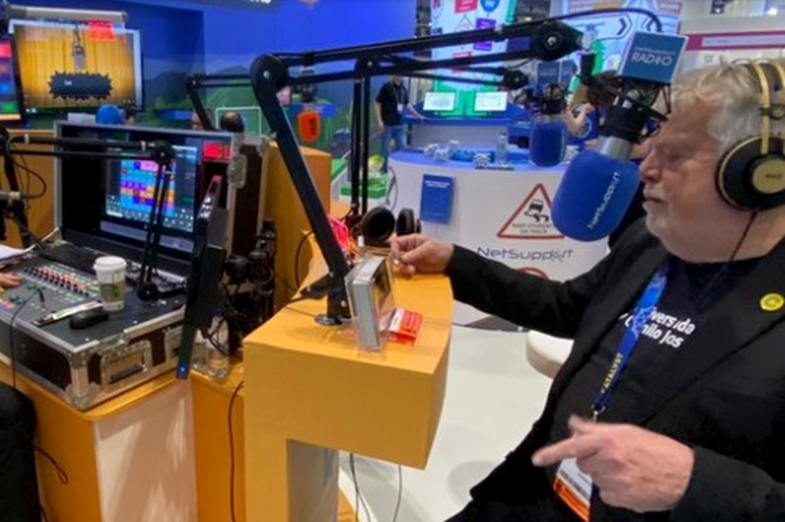
- Back in the 90s Europe dabbled with the idea of a trans-national Research Lab, looking to surpass the then successes of MIT, Stanford etc. The EU i3 project failed because of national squabbling, but really something like that would cut the costs of the needed Blue Sky thinking for SE Asia – would certainly attract commercial sponsorship too – and in 2022 with much better connectivity could be a very successful distributed engine for change.
- Published in Blog
TIESEA Project Introduction
The Technology-enabled Innovation in Southeast Asia (TIESEA) project aims to find solutions as to ‘’what works” in EdTech. The project began in late 2021 with the conducting of national surveys of the EdTech landscape in four countries in the region – Cambodia, Indonesia, Philippines and Vietnam. These were designed to include an overview of the local EdTech situations and to review those interventions that have been successful in improving education outcomes. The detailed country situational analyses in the four countries, which also reported on the results of a teacher-skill survey, have provided a showcase for some of the EdTech suppliers and projects operating in each of the countries.
The leading EdTech players, identified country by country, will be invited to become project partners to work with project implementers to run intervention pilots that will run for one year in each country. The research design will be backed up by rigorous monitoring and evaluation procedures that will check on progress over the course of the year-long projects. Several important criteria will guide the EdTech pilots – they should be affordable, scalable and sustainable at a national level, to the extent that they could become more widely adopted by education ministries at the end of the year-long project intervention. The interventions should be able to demonstrate a positive impact on the quality of learning and the achievements of the students in the participating schools.
During the early part of 2022 workshops are taking place, in the form of webinars, to share the findings of Digital eReadiness Surveys in each country with key government officials and other key stakeholders in the participating countries. This workshop series will culminate in a regional webinar with a wide audience, international keynote speakers and an expert panel. The conference will reflect upon the lessons learned during the past two years of remote learning, as EdTech has had a critical role to play in maintaining learning continuity during the enforced school closures.
As the EdTech interventions proceed over the course of school years 2022 and early 2023 regular updates will be included on the project website.
The lessons learned and the results of the EdTech interventions will be collated, analysed, and presented at a major in-person international conference and EdTech event to be held in the region in September 2023. This conference is aimed to be a capstone event to which an international audience of policy-influencers and decision-makers will be invited.
All the major international EdTech players will be represented, and, under the aegis of the Asian Development Bank and the Japanese Fund for Poverty Reduction, the project implementers will focus on, and highlight, the key elements that make EdTech interventions successful.
EdTech solutions have a huge role to play in the contributions they can make as education systems begin to be remodelled to address the twin challenges of the Fourth Industrial Revolution and the ongoing challenges of remote learning and school closures.
- 1
- 2
